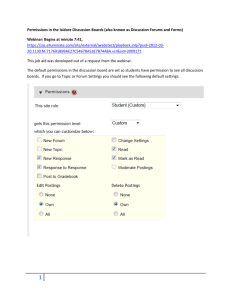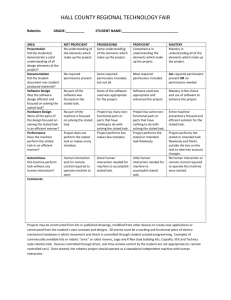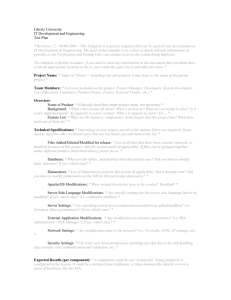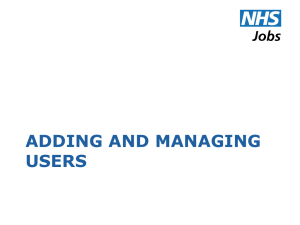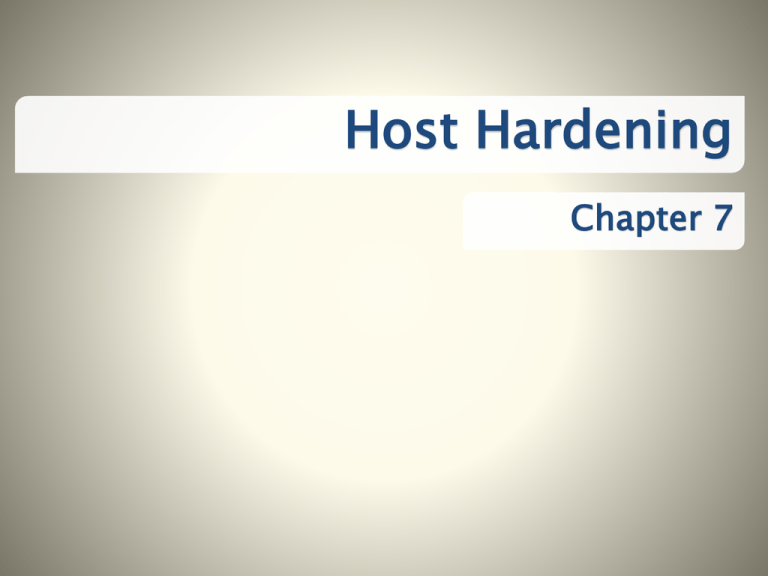
Host Hardening
Chapter 7
Threats to Hosts
• The Problem
– Some attacks inevitably reach host
computers
– So servers and other hosts must be
hardened— a complex process that
requires a diverse set of protections to be
implemented on each host
– Another name for diverse set of protections
is?
2
Threats to Hosts
• What Is a Host?
– Anything with an IP address is a
host (because it can be attacked)
– Servers
– Clients (including mobile
telephones)
– Routers (including home access
routers) and sometimes switches
– Firewalls
3
Elements of Host Hardening
Backup
Backup
Backup
Restrict physical access to hosts (see Chapter
5)
Install the operating system with secure
configuration options
• Change all default passwords, etc.
4
Change All Default Passwords
• Internet Census 2012
• A huge Hack!
• “While playing around with the Nmap Scripting Engine (NSE) we
discovered an amazing number of open embedded devices on the
Internet.”
• “Two years ago while spending some time with the Nmap Scripting
Engine (NSE) someone mentioned that we should try the classic telnet
login root:root on random IP addresses.”
– Also looked fro admin:admin; admin:blank; root:blank; blank:blank
• The vast majority of all unprotected devices are consumer routers or settop boxes which can be found in groups of thousands of devices. A group
consists of machines that have the same CPU and the same amount of
RAM. However, there are many small groups of machines that are only
available a few to a few hundred times. We took a closer look at some of
those devices to see what their purpose might be and quickly found
IPSec routers, BGP routers, x86 equipment with crypto accelerator cards,
industrial control systems, physical door security systems, big
Cisco/Juniper equipment and so on.
Elements of Host Hardening
Minimize the applications that run on the host
Harden all remaining applications on the host
(see Chapter 8)
Download and install patches for operating
vulnerabilities
Manage users and groups securely
Manage access permissions for users and
groups securely
6
Elements of Host Hardening
Encrypt data if appropriate
Add a host firewall
Read operating system log files regularly for
suspicious activity
Run vulnerability tests frequently
7
Security Baselines and
Systems Administrators
• Security Baselines Guide the Hardening Effort
– Specifications for how hardening should be done
– Needed because it is easy to forget a step
– Different baselines for different operating systems
and versions
– Different baselines for servers with different
functions (webservers, mail servers, etc.)
– Used by systems administrators (server
administrators)
• Usually do not manage the network
8
Disk Images
• Can also create a well-tested secure
implementation for each operating system
versions and server function
• Save as a disk image
• Load the new disk image on new servers
9
Baseline Checklists
National Institute of Standards and Technology
◦ National Checklist Program
“U.S. government repository of publicly available security
checklists (or benchmarks) that provide detailed low level
guidance on setting the security configuration of operating
systems and applications.”
Example for Internet Explorer….
◦ Center for Internet Security
“not-for-profit organization focused on enhancing the cyber
security readiness and response of public and private sector
entities, with a commitment to excellence through
collaboration.”
Example for Windows 7
Copyright Pearson
Prentice-Hall 2010
10
Checklists are good but….
Could you imagine how long it would take for
that IE checklist to be done/confirmed?
Can this process be automated?
Security Content Automation Protocol (SCAP)
◦ “(SP) 800-126, is ―a suite of specifications that
standardize the format and nomenclature by which
security software products communicate software
flaw and security configuration information.”
automatically verifying the installation of patches
checking system security configuration settings
examining systems for signs of compromise
Copyright Pearson
Prentice-Hall 2010
11
SCAP Recommendations
Organizations should use SCAP expressed checklists
◦ documents desired security configuration settings, installed patches,
and other system security elements in a standardized format
SCAP can be used to demonstrate compliance
◦ SCAP has been mapped to FISMA
Use standard SCAP enumerations
◦ Common Vulnerabilities and Exposures (CVE)
◦ Common Configuration Enumeration (CCE)
◦ Common Platform Enumeration (CPE)
Use SCAP for vulnerability testing and scoring
◦ Provides repeatable measures that can be compared over time
Use SCAP validated products
◦ nCircle Configuration Compliance Manager
Vendors should adopt SCAP
Copyright Pearson
Prentice-Hall 2010
12
Virtualization
Multiple operating systems running
independently on the same physical machine
System resources are shared
Increased fault tolerance
Rapid and consistent deployment
Reduced labor costs
13
Vulnerabilities and Exploits
• Vulnerabilities
– Security weaknesses that open a program to
attack
– An exploit takes advantage of a vulnerability
– Vendors develop fixes
– Zero-day exploits: exploits that occur before fixes
are released
– Exploits often follow the vendor release of fixes
within days or even hours
– Companies must apply fixes quickly
14
Vulnerabilities and Exploits
• Fixes
– Work-arounds
• Manual actions to be taken
• Labor-intensive so expensive and error-prone
– Patches:
• Small programs that fix vulnerabilities
• Usually easy to download and install
– Service packs (groups of fixes in Windows)
– Version upgrades
15
Operating System Market Share
16
Web Browser Market Share
17
Applying Patching
• Problems with Patching
– Must find operating system patches
• Windows Server does this automatically
• LINUX versions often use rpm
– Companies get overwhelmed by number of
patches
• Latest figures by CERT in 2008
– 44,000 vulnerabilities catalogued
• Use many programs; vendors release many patches per
product
• Especially a problem for a firm’s many application
programs
18
Applying Patching
• Problems with Patching
– Cost of patch installation
• Each patch takes some time and labor costs
• Usually lack the resources to apply all
– Prioritization
• Prioritize patches by criticality
• May not apply all patches, if risk analysis does not
justify them
19
Compliance or Security, What
Cost?
Craig Wright, 2011
20
Hypothesis/Background
• Audits are geared towards expressing
compliance with IT Security vs. tests of IT
Security controls
• Data collection
– 2,361 audit reports from 1998-2010
– Australian and US audits
• SOX, PCI-DSS, APRA, BASELII, AML-CTF
21
Findings
• 30% of tests evaluated effectiveness of the
control process
• System security was only validated in 6.5% of
reports
– By testing that controls met the documented
process
– NOT by testing the controls
• Only 32 of 542 organizations utilized baseline
templates
22
Patch Compliance Findings
# Analyzed
Days Between
Patch
Policy Patch Time
Prior Audit
Reports Noting
Patching
Windows Server
1571
86.2 (mean)
56-88 (CI)
98.4%
Windows Clients
13591
48.1
30-49
96.6%
Other Windows
Applications
30290
125.2
68 without patch
18.15%
Internet facing
routers
515
114.2
58.1
8.7%
Internal Routers
1323
267.8
73.2
3.99%
Internal Switches
452
341.2
87.5
1.2%
Firewalls
1562
45.4
25-108
70.7%
23
Managing Users and Groups
XYZ
• Accounts
– Every user must have an account
XYZ
• Groups
– Individual accounts can be consolidated into
groups
– Can assign security measures to groups
– Inherited by each group’s individual members
– Reduces cost compared to assigning to individuals
– Reduces errors
24
The Super User Account
• Super User Account
– Every operating system has a super user account
– The owner of this account can do anything
– Called Administrator in Windows
– Called root in UNIX
• Hacking Root
– Goal is to take over the super user account
– Will then “own the box”
– “rooted”
25
The Super User Account
• Appropriate Use of a Super User Account
– Log in as an ordinary user
– Switch to super user only when needed
• In Windows, the command is RunAs
• In UNIX, the command is su (switch user)
– Quickly revert to ordinary account when super
user privileges are no longer needed
26
• Permissions
– Specify what the user or group can do to files,
directories, and subdirectories
• Assigning Permissions in Windows
– Right-click on file or directory
– Select Properties, then Security tab
– Select a user or group
– Select the 6 standard permissions (permit or deny)
– For more fine-grained control, 13 special
permissions
27
Assigning Permissions in Windows
Select a
user or
group
Inheritable
permissions
Standard
permissions
Advanced
permissions
28
The Inheritance of Permission
• Inheritance
– If the Include inheritable permissions from this
object’s parent is checked in the security tab, the
directory receives the permissions of the parent
directory.
– This box is checked by default, so inheritance from
the parent is the default
29
The Inheritance of Permission
XYZ
• Inheritance
– Total permissions include
XYZ
• Inherited permissions (if any)
• Plus the Allow permissions checked in the Security tab
• Minus the Deny permissions checked in the Security tab
• The result is the permissions level for a directory or file
30
The Inheritance of Permission
• Directory Organization
– Proper directory organization can make
inheritance a great tool for avoiding labor
– Example: Suppose the all logged-in user group is given
read and execute permissions in the public programs
directory
– Then all programs in this directory and its
subdirectories will have read and execute permissions
for everyone who is logged in
– There is no need to assign permissions to
subdirectories and their files
31
Windows vs. Unix
Category
Number of
permissions
Windows
6 standard, 13
specialized if
needed
UNIX
Only 3: read (read only),
write (make changes),
and execute (for
programs).
Referred to as rwx
For a file or directory, Any number of
The account owner
different permissions individual accounts A single group, and
can be assigned to
and groups
All other accounts
32
Vulnerability Testing
• Mistakes Will Be Made in Hardening
– So do vulnerability testing
• Run Vulnerability Testing Software on
Another Computer
– Run the software against the hosts to be tested
– Interpret the reports about problems found on
the server
• This requires extensive security expertise
– Fix them
33
Get Permission for Vulnerability Testing
– Looks like an attack
• Must get prior written agreement
– Vulnerability testing plan
• An exact list of testing activities
• Approval in writing to cover the tester
• Supervisor must agree, in writing, to hold the tester
blameless if there is damage
• Tester must not diverge from the plan
34
Windows Client PC Security
• Client PC Security Baselines
– For each version of each operating system
– Within an operating system, for different types of
computers (desktop versus notebook, in-site
versus external, high-risk versus normal risk, and
so forth)
• Automatic Updates for Security Patches
– Completely automatic updating is the only
reasonable policy
35
Windows Client PC Security
• Antivirus and Antispyware Protection
– Important to know the status of antivirus protection
– Users turn off deliberately or turn off automatic
updating for virus signatures
– Users do not pay the annual subscription and so get
no more updates
• Windows Advanced Firewall
– Stateful inspection firewall
– Accessed through the Windows Action Center
36
Centralized PC Security Management
• Importance
– Ordinary users lack the knowledge to manage
security on their PCs
– They sometimes knowingly violate security
policies
– Also, centralized management often can reduce
costs through automation
37
Standard Configurations for PCs
– May restrict applications, configuration settings,
and even the user interface
– Ensure that the software is configured safely
– Enforce policies
– More generally, reduce maintenance costs by
making it easier to diagnose errors
38
Centralized PC Security Management
• Network Access Control (NAC)
– Goal is to reduce the danger created by computers
with malware
– Control their access to the network
Network
39
Centralized PC Security Management
• Network Access Control (NAC)
– Stage 1: Initial Health Check
• Checks the “health” of the computer before allowing it
into the network
• Choices:
– Accept it
– Reject it
– Quarantine and pass it to a remediation server;
retest after remediation
40
Centralized PC Security Management
• Network Access Control (NAC)
– Stage 2: Ongoing Traffic Monitoring
• If traffic after admission indicates malware on the
client, drop or remediate
• Not all NAC systems do this
41
The Future is Now??
Application Security
Chapter 8
• Some attacks inevitably get through network
protections and reach individual hosts
• In Chapter 7, we looked at host hardening
• In Chapter 8, we look at application hardening
• In Chapter 9, we will look at data protection
45
46
47
48
49
50
51
52
53
54
55
56
57
Copyright Pearson Prentice-Hall
2010
58
Copyright Pearson Prentice-Hall
2009
59
60
61
62
Application
Application
Variables
Variables
Return Address
New Return Address
Overwrites
Return
Address
Exploit/ShellCode
Lets say this is computer memory running an application.
The application is paused to get data
So the address of where the application is before interruption is stored
So we can return after getting data, but the return address is overwritten and after
the pause, a new program begins processing
63
64
65
66
67
68
69
70
71
72
73
74
75
76
77
Yahoo Developer Network Attack
79
80
81
82
83
84
85
8.3: Browser Attacks and Protections
• Client-Side Scripting (Mobile Code)
– Scripting languages (not full programming
languages)
• A script is a series of commands in a scripting language
• JavaScript (not scripted form of Java)
• VBScript (Visual Basic scripting from Microsoft)
• A script usually is invisible to users
86
You like beef?
click here.
http://www.micosoft.com
87
88
89
90
My Hack
mydebitcredit.com
Copyright Pearson Prentice-Hall
2010
91
92
93
94
95
Cop
yrig
ht
Pear
son
Pren
tice
96
I had 69 out of date themes!!!!!!
97
98
99
100
101
102
103
And…
• CloudFlare
– “CloudFlare leverages the knowledge of a diverse
community of websites to power a new type of
security service. Online threats range from
nuisances like comment spam and excessive bot
crawling to malicious attacks like SQL injection and
denial of service (DOS) attacks. CloudFlare
provides security protection against all of these
types of threats and more to keep your website
safe.”
Copyright Pearson
Prentice-Hall 2010
104
It’s more than you think…
•
•
•
•
Chapter 7 – Operating Systems / Hosts
Chapter 8 – Applications
Chapter 9 – Data
But social networks connect us with
everything….
• Permissions
Copyright Pearson
Prentice-Hall 2010
105


